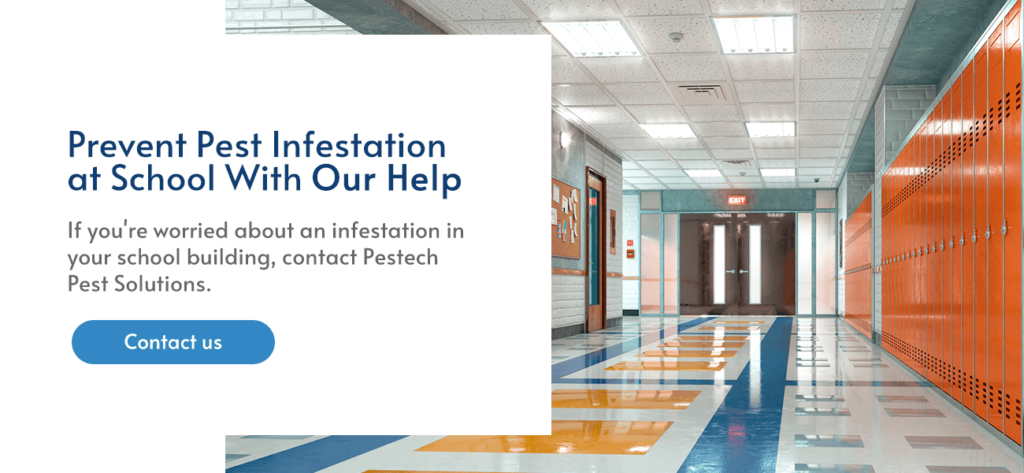Most Common School Pest Infestations
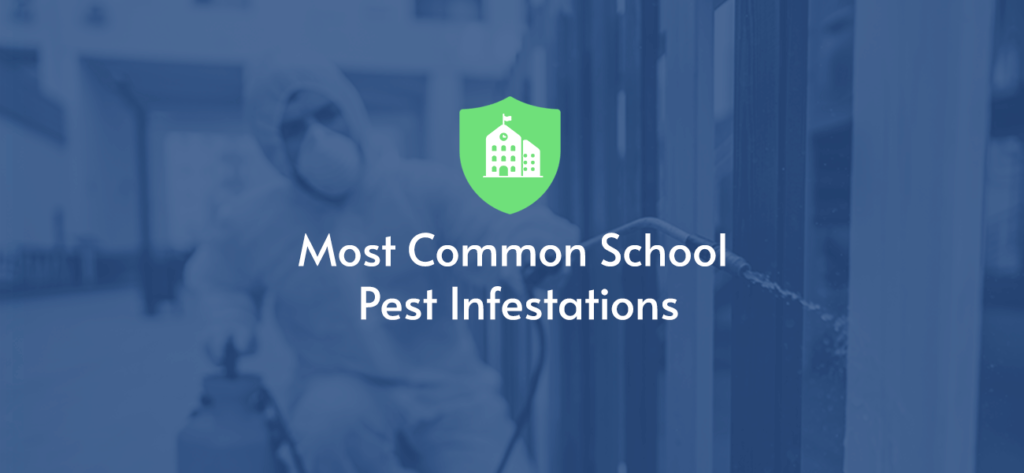
Parents depend on schools to be safe, engaging places for their children to learn and grow. This means providing good teachers and challenging coursework — it also means keeping the building safe and clean. Just because schools are a place of learning doesn’t mean they’re immune to infestations. The social atmosphere also makes it easier for students to transmit parasites or diseases to each other, especially if they’re young.
Many types of pests can make their homes in school buildings. It’s important to prevent these infestations at the source or otherwise control them as soon as possible to avoid parasites or diseases from spreading among students. Here are some of the most common school pest problems and what you can do to prevent them from infesting your building.
Ants
If you’ve ever had a picnic or discovered an old cookie trapped under your kitchen table, chances are you’re familiar with ants. Ants are small, social insects that live in colonies of thousands of individuals. Many types of ants, such as carpenter ants, burrow into wood. Others, like fire ants, have bites that cause painful welts and blisters. Some ant species can even fly.
Once ants find food, they lay pheromone trails to direct other ants to it. This allows them to quickly infest any food they find, contaminating it and making it unsafe to eat. Fire ants can also be dangerous to those allergic to them.
Once ants infest a building, they are difficult to remove unless you destroy the queen. Until the queen is killed, she continues breeding and creating more ants. Keep foods covered and clean food spills, especially sweet things like sugar and honey, to help prevent infestations. Remove rotting wood or damp spots, as these are ideal nesting spots for carpenter ants.
Bed Bugs
Bed bugs are parasites that infest furniture and feed on human blood. An adult bed bug can lay between five to seven eggs per week and as many as five hundred over the course of their lives. They typically feed every five to ten days but can go several months without feeding if necessary.
While bed bugs cannot fly, they cling to infested surfaces, such as clothing and luggage, and spread to bedding or furniture. Once there, their constant biting can cause itching, skin irritations and allergic reactions. Excessive scratching can lead to secondary skin infections. If bed bugs infest their victim’s bed, they can make it difficult to sleep, increasing stress.
If someone discovers a bed bug on a student, keep calm. Bed bugs only feed on people and don’t infest bodies like other parasites. Monitor your classrooms and react accordingly to any infestations you find.
Lice
Lice, or head lice, as they’re sometimes called, are small, wingless parasites that feed on human blood. The adult lays eggs that stick to hair follicles until they hatch. They spend eight to nine days as a nymph, feeding off of the host’s blood every few hours, until they reach adulthood and lay eggs of their own.
While lice don’t spread disease, they do cause severe itching. Excessive itching can cause secondary skin infections. They won’t stop infesting their host until curative measures are taken.
While head lice cannot fly, they can crawl from their host’s head onto clothing or furniture. They usually spread via shared towels, hats and hair accessories, blankets or jackets. This makes them particularly spreadable in schools, where students often share hats or jackets with friends. If you suspect head lice in your school, have the students checked and dissuade them from sharing clothing.
Rodents
Rats and mice are common pest rodents. Both are small, omnivorous creatures that make their homes inside walls and under floors. Once there, they infest food stores and chew wires. Pups reach sexual maturity very quickly, making their reproductive rates even higher.
Aside from the property damage they can cause by chewing through walls and wires, rodents also pose several health concerns. They can contaminate food and make it unsafe to eat, both with their presence and excrement. Rats can spread more than 35 diseases, either through their excrement, their bites, through bugs that live in their fur, or through direct contact with them.
The thing that most commonly attracts rodents to a building is food. Make sure that all food is covered and that spills are cleaned quickly and thoroughly. If any classrooms have pets, keep pet food covered. Rodents are also attracted to large amounts of abandoned clutter or garbage, so keep storage areas clean.
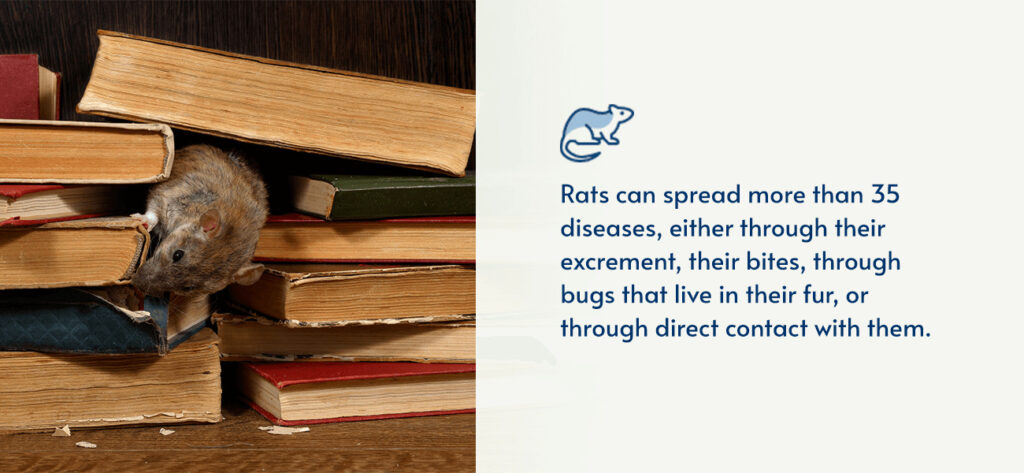
Cockroaches
Cockroaches are hard-shelled insects, with the most common species in the US being the German cockroach. Cockroaches are attracted to food and moisture, although different species prefer different moisture levels. They feed on both fresh and decaying organic matter.
Cockroaches can trigger asthma attacks in those allergic to their sheddings, saliva or droppings. They also carry several types of bacteria, including salmonella and streptococcus, which can spread to humans through food. Because cockroaches have long been considered “dirty” insects, seeing them can also cause considerable emotional distress.
Due to their preference for food and moisture, cockroaches are most common in kitchens, bathrooms and garbage storage areas. Keep these areas clean and dry where possible to keep them from infesting your building. As with other pests, be sure to keep unused food covered when possible. Clean under fridges or between ovens and cabinets, where grease and food can accumulate.
Spiders
Spiders are arachnids best known for building webs to catch prey. There are thousands of species of spiders, not all of which pose a threat to humans. However, there are also many venomous species of spiders that are harmful and even fatal to humans they bite.
The black widow, brown recluse and aggressive hobo spider are three species that pose the most threat in average school environments. The venom in their bites can cause severe pain, skin irritation and even death in some cases. These species usually only bite if provoked — however, their nests are not always immediately visible, and accidentally disturbing them can provoke them.
Spiders usually prefer to nest in quiet, dark places where they won’t be disturbed. This includes storage rooms, closets, infrequently used cabinets and other crawlspaces. If you’re concerned about spider infestations, it’s important to check these places for nests.
Flies
Unless you live somewhere freezing all year, you’ve most likely encountered a fly at some point. While there are thousands of fly species, house flies are the most common. They are small, flying insects that feed on organic matter or animal waste. They feed by vomiting digestive juices onto their food and sucking them up once they’ve liquified the contacted surface.
House flies are irritating, but they don’t bite. The real danger comes from the diseases they carry. Due to their preferred diets and methods of eating, flies are often covered in viruses and bacteria. They can cause illnesses such as cholera, dysentery and food poisoning in humans. These bacteria and viruses also mean the food they come into contact with is unsafe to eat.
The best way to manage fly infestations is to remove their habitats at the larval stage. This includes garbage, decaying plant or animal matter and generally moist environments. Fly traps and fly paper can also be effective in controlling the adult population.
Ticks
Ticks are small parasites that bury their heads in their host and feed off of their blood. Their eggs develop into larva in the spring, making the late spring and summer the highest risk for tick bites. A single tick doesn’t take enough blood to pose a threat, but it can transfer Lyme disease if they aren’t noticed and removed in time.
Ticks live in wooded areas when they aren’t infecting a host. If students are hiking or exploring brush, make sure they wear protective clothing and fence off potentially tick-infested areas.
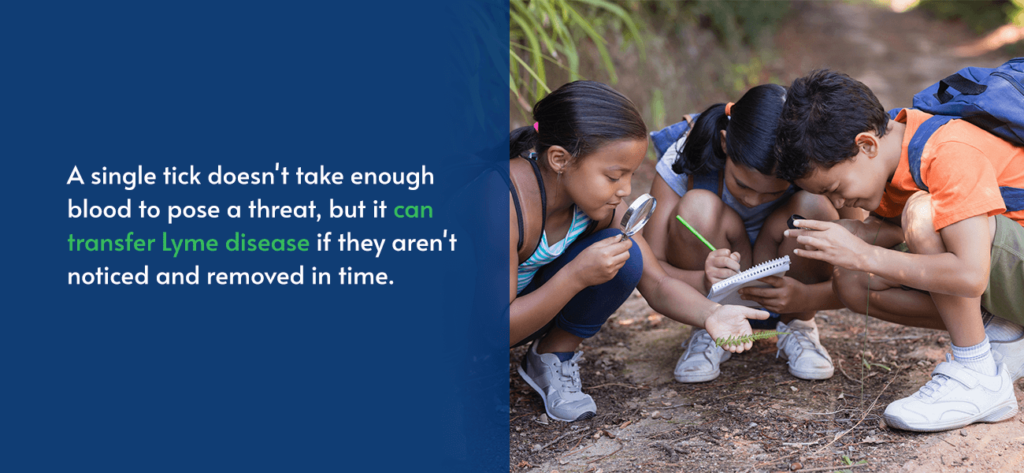
Bees and Wasps
Bees and wasps are stinging insects that live in hives or nests. While they appear similar at first glance, bees have much hairier bodies than wasps and are less aggressive. Bees are also almost exclusively pollinators and use nectar as a food source, while wasps seek out young insects to feed their young. Both make nests near or on the sides of buildings.
The biggest danger from bees and wasps is their stings. While stings themselves aren’t dangerous to most people, they can be fatal to those with allergies. Even if the victim isn’t allergic, stings are painful and cause skin irritation. Most bees can only sting one time, while wasps can sting multiple times per insect. Bee stingers often end up lodged in the skin with an attached venom sack and must be removed.
Bees are attracted to flowers. Both bees and wasps are attracted to food, particularly sweet food. If students leave sweet or syrupy drinks uncovered outside, it can attract them. They are also attracted to outside garbage cans and pools of water.
Mosquitoes
Mosquitoes are small, flying insects that feed on sugars and blood. Only the male mosquitoes feed on sugars and usually obtain them through juices from plants, while female mosquitoes feed exclusively on blood. There are about 3,500 species of mosquitoes in various climates all over the world. While they can live in desert environments, many species prefer moist climates and standing water.
Mosquito bites are generally not painful unless the victim is allergic, and a single mosquito doesn’t take enough blood to be harmful. However, mosquito saliva causes bites to itch and swell, and excessive scratching can lead to secondary skin infections. Mosquitoes can also carry microorganisms that cause serious disease, such as malaria, or that lead to parasitic infestations, such as botflies.
Controlling water is crucial in avoiding mosquito infestations. Any areas with pools of standing water or large amounts of damp, decaying vegetation can become a breeding ground for mosquitoes. Screen doors and common insect repellants also help keep them at bay.
Termites
Termites, similarly to ants, are social insects that live in colonies. They’re best known for eating wood, but they also eat soil, dead leaves and paper. There are many termite species, and while none pose a health risk to humans, they can cause severe damage to wooden structures and books if left unchecked.
Termites prefer moist, damp spots to build nests in, so keeping wooden structures dry is crucial in preventing infestations. It’s also important to keep an eye out for signs of termite infestations so they can be removed as quickly as possible if they do infest structures. Signs of infestations include swollen or bending wood, spots that look like water damage and maze-like tubes running through wooden structures.
Most Common Places for School Infestations
With so many pests varieties, it may seem impossible to police your entire school building for them. However, despite their differences, there are several common places pest species are drawn to:
- Cafeterias and kitchens: Easy access to food is a lure for many pest species, and kitchens and cafeterias are where food is most likely to be left out or spilled. They also provide plenty of places for pests to hide, such as under tables, behind appliances and in cabinets.
- Dumpsters: Dumpsters are another breeding ground for pests, as they’re dark, damp, full of rotting food and only disturbed when more food is added or removed.
- Locker rooms: Locker rooms are often warm and damp, creating a comfortable nesting ground for many pests. Lockers also provide them with dark places to hide.
- Landscapes: It might seem unavoidable that pest species would live outside, but poorly maintained landscapes attract more of them than usual. Once there, they can infest nearby buildings.
- Storage: Dark, neglected spaces with lots of clutter and plenty of hiding places make great nesting grounds for various pest species. These can include storage rooms, closets or spaces as small as a cubby or desk.
Keeping an eye on these spaces and ensuring they’re as clean and dry as possible can help reduce the chance of infestation. This is harder in some places than others — it’s more difficult to keep a dumpster clean than a desk — but even monitoring these areas can help you cut off infestations before they grow out of control.
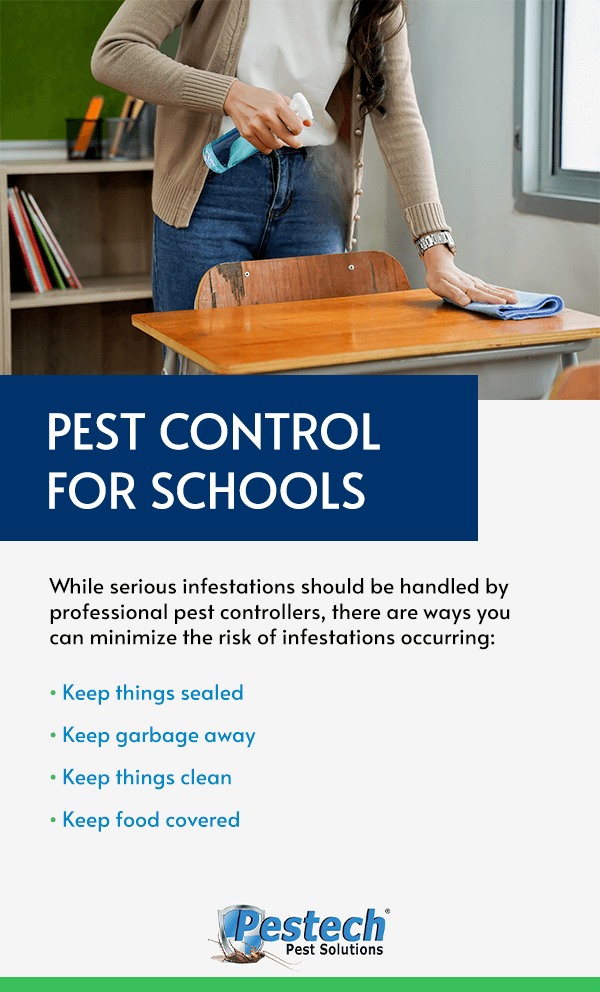
Pest Control for Schools
While serious infestations should be handled by professional pest controllers, there are ways you can minimize the risk of infestations occurring:
- Keep things sealed: Certain species of pests, such as rodents and spiders, like making their homes under floors or inside walls. Make sure your building’s cracks are properly sealed to prevent any creatures from moving in.
- Keep garbage away: There’s no real way to keep garbage clean, but you can make sure it’s far enough away from your building to keep out anything it attracts. Make sure your garbage is a safe distance from your food preparation rooms and disposed of regularly.
- Keep things clean: Standing water, garbage and clutter make for excellent nesting and breeding grounds. If you want to prevent that from happening, keep your building clean. This means checking storage rooms, cleaning out gutters to prevent overflow and properly disposing of any garbage.
- Keep food covered: Leaving food out or not properly cleaning spilled food is an easy way to attract unwanted pests. Make sure that any food not being eaten or prepared is covered properly and stored somewhere clean. If a student or faculty member spills food, clean it quickly and thoroughly.
Prevent Pest Infestations at School With Our Help
School is supposed to be a fun, educational place for children to grow and develop their minds. To do this, they need a clean, safe environment without the threat of pests bringing diseases or following them back home.
If you’re worried about an infestation in your school building, contact Pestech Pest Solutions. We offer high-quality services from the largest family-owned pest control business in the state. Our 100% satisfaction guarantee means we won’t leave until your building is pest-free. If we aren’t successful the first time, we’ll keep coming back until we are at no additional charge. Contact us and schedule your commercial pest control inspection today!

